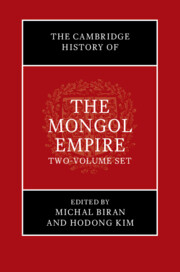Book contents
- The Cambridge History of the Mongol Empire
- The Cambridge History of the Mongol Empire
- Copyright page
- Dedication
- Contents
- Figures in Volume I
- Figures in Volume II
- Maps in Volume I
- Maps in Volume II
- Tables in Volume I
- Contributors to Volume I
- Contributors to Volume II
- Acknowledgments
- Notes on Dates and Transliterations
- Abbreviations
- Volume I
- Volume II
- Volume II Part 1 Literary Sources
- Volume II Part 2 Archaeological and Visual Sources
- 17 Archaeological Sources
- 18 Archaeological Sources
- 19 Archaeological Sources
- 20 Archaeological Sources
- 21 Visual Sources
- Index to Volume I
- Index to Volume II
- References
17 - Archaeological Sources
Mongolia and the Yuan
from Volume II Part 2 - Archaeological and Visual Sources
Published online by Cambridge University Press: 01 January 2024
- The Cambridge History of the Mongol Empire
- The Cambridge History of the Mongol Empire
- Copyright page
- Dedication
- Contents
- Figures in Volume I
- Figures in Volume II
- Maps in Volume I
- Maps in Volume II
- Tables in Volume I
- Contributors to Volume I
- Contributors to Volume II
- Acknowledgments
- Notes on Dates and Transliterations
- Abbreviations
- Volume I
- Volume II
- Volume II Part 1 Literary Sources
- Volume II Part 2 Archaeological and Visual Sources
- 17 Archaeological Sources
- 18 Archaeological Sources
- 19 Archaeological Sources
- 20 Archaeological Sources
- 21 Visual Sources
- Index to Volume I
- Index to Volume II
- References
Summary
In recent years, archaeology has become increasingly important in the study of the Mongol Empire in East Asia. Historically, the remains in China, Korea, and Siberia have been investigated, but when archaeological research on the Mongolian plateau began at the end of the twentieth century, many significant materials were found. Those have provided useful information on the formation process of the Mongol Empire. Notable sites are the Avraga ruins, where an iron workshop that supported Chinggis Khan’s military power and his mausoleum were found; and Qaraqorum, capital of the United Empire. Newly acquired archaeological materials have been analyzed in collaboration with natural scientists, illuminating aspects of daily life such as clothing, food, and housing, as well as climate change and its impact on the rise and fall of the Mongol Empire.
Keywords
- Type
- Chapter
- Information
- The Cambridge History of the Mongol Empire , pp. 1275 - 1311Publisher: Cambridge University PressPrint publication year: 2023

